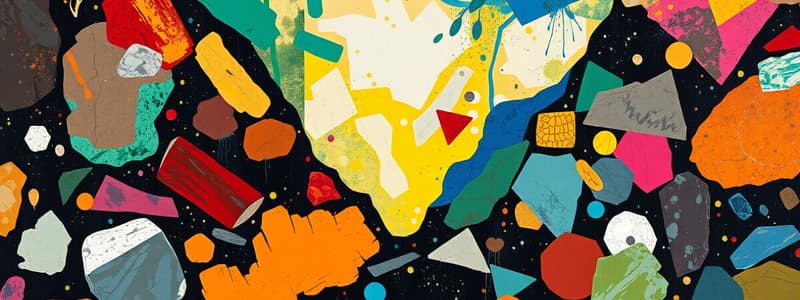Podcast
Questions and Answers
Minerals are naturally occurring ______ substances found in the Earth's crust.
Minerals are naturally occurring ______ substances found in the Earth's crust.
inorganic
Minerals are extracted from ______, processed and used for industrial purposes.
Minerals are extracted from ______, processed and used for industrial purposes.
ores
Metallic minerals are generally found in igneous and ______ rocks.
Metallic minerals are generally found in igneous and ______ rocks.
metamorphic
Gold, copper, and ______ are examples of metallic minerals.
Gold, copper, and ______ are examples of metallic minerals.
Non-metallic minerals do not contain ______.
Non-metallic minerals do not contain ______.
Mineral fuels such as coal, petroleum, and natural gas are mostly found in ______ rocks.
Mineral fuels such as coal, petroleum, and natural gas are mostly found in ______ rocks.
Minerals can be broadly classified as ______ and non-metallic.
Minerals can be broadly classified as ______ and non-metallic.
The process of cooling and solidifying magma leads to the formation of ______ rocks.
The process of cooling and solidifying magma leads to the formation of ______ rocks.
Pyrite, known as 'fool's gold', is a type of ______ mineral.
Pyrite, known as 'fool's gold', is a type of ______ mineral.
The primary component of porcelain is a non-metallic mineral called ______.
The primary component of porcelain is a non-metallic mineral called ______.
Flashcards are hidden until you start studying
Study Notes
Understanding Minerals
- Minerals are naturally occurring inorganic substances in the Earth's crust, solid and homogeneous, often crystalline.
- Over 5,000 minerals have been identified, with ores being rock types with a high concentration of specific minerals.
- Organic substances like coal, petroleum, and natural gas, primarily used as fuels, are classified as fossil fuels.
Types of Minerals
Metallic Minerals
- Characteristics include being hard, shiny, ductile, and malleable.
- Generally found in igneous and metamorphic rocks.
- Examples: Gold, copper, tin, and zinc.
Non-metallic Minerals
- Lacking metal, these minerals are brittle, inflexible, and not shiny.
- Kaolinite, used in porcelain and light bulbs, serves as an example.
Types of Rocks
- Sedimentary Rocks: Formed by compacted sediments over time. Examples include sandstone, coal, shale, and limestone.
- Igneous Rocks: Result from the cooling and solidification of magma; granite and basalt are common examples.
- Metamorphic Rocks: Created under intense heat and pressure from existing rocks (sedimentary or igneous). Examples include marble (from limestone) and diamonds (from carbon).
Mineral Fuels
- Formed from decayed plants and animals over millions of years, primarily found in sedimentary rocks.
- Key examples include coal, petroleum, and natural gas.
- Anthracite, a high-carbon variant of coal, is noted for its shiny appearance.
Importance of Minerals
- Minerals are crucial natural resources serving as raw materials for industries.
- Understanding the different types of minerals and their origins is vital for conservation and sustainable use.
Studying That Suits You
Use AI to generate personalized quizzes and flashcards to suit your learning preferences.




